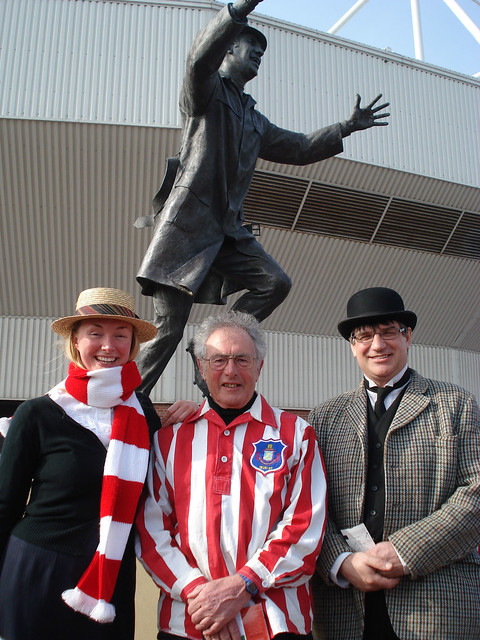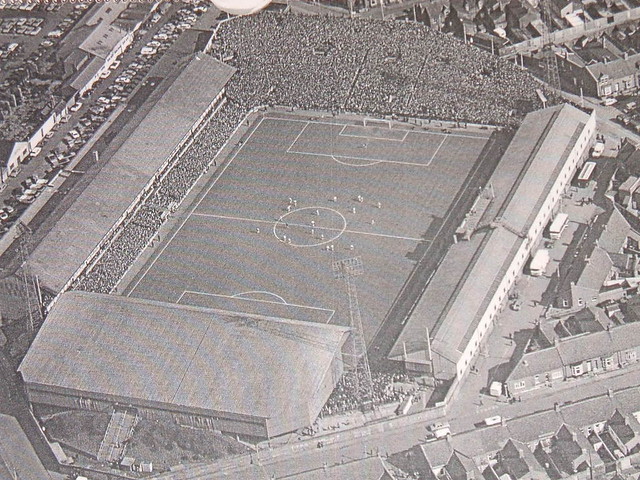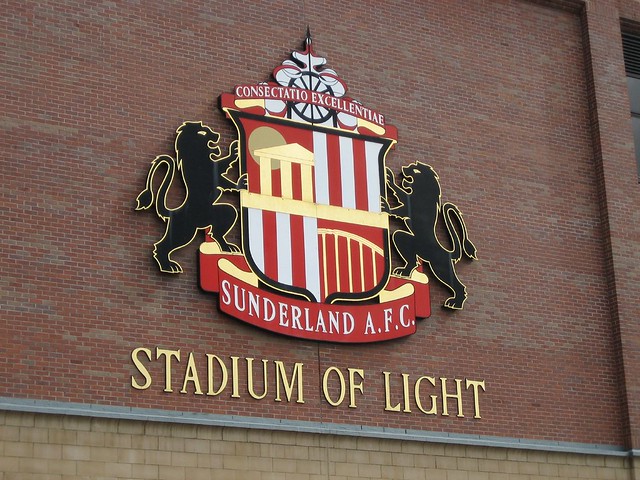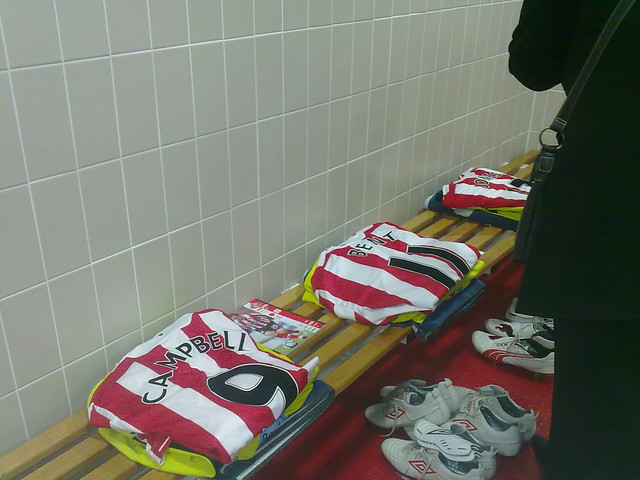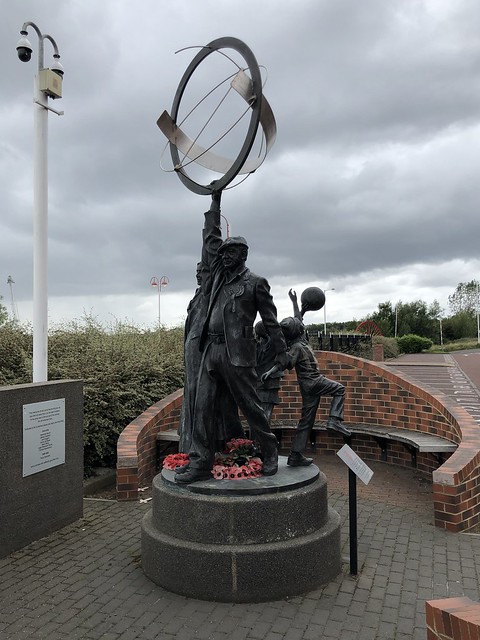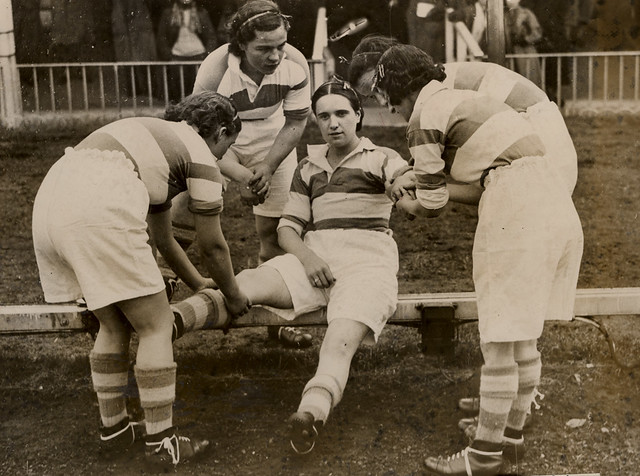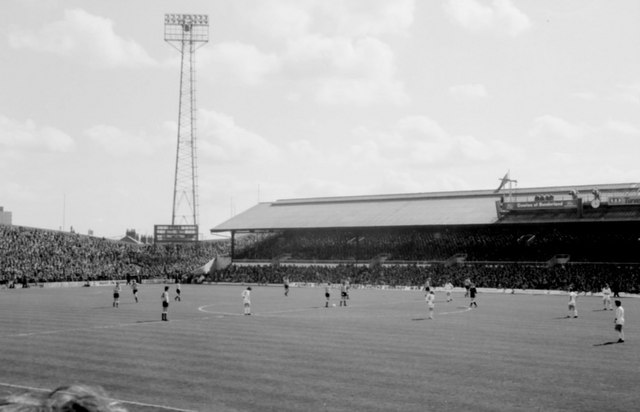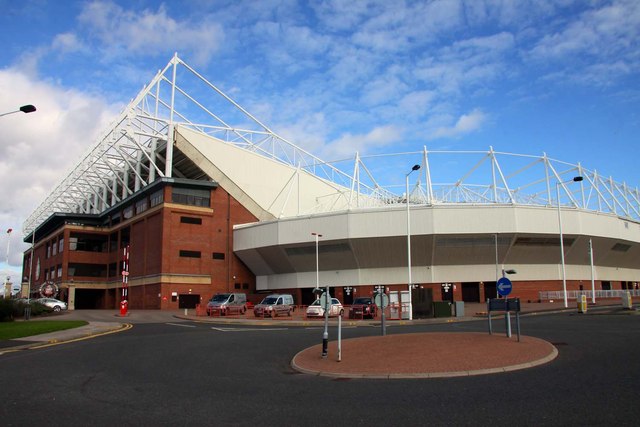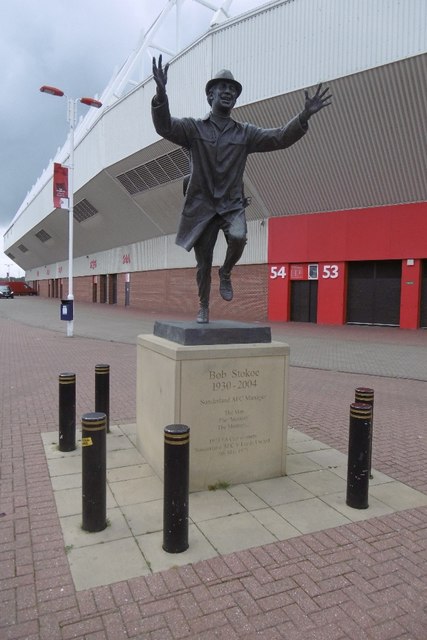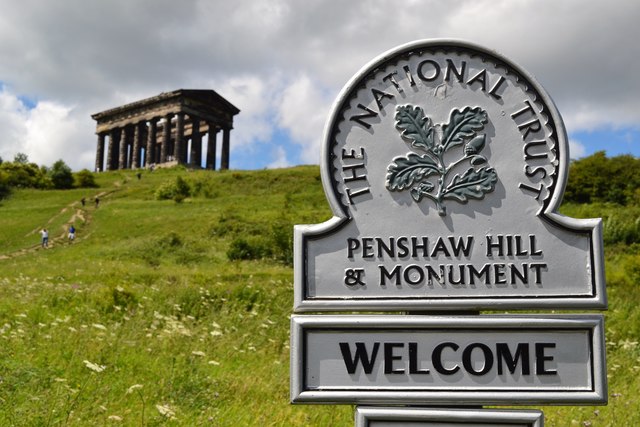Topics > Sport > Football > Sunderland AFC
Sunderland AFC
 Sunderland Association Football Club was founded on 17th October 1879 by schoolmaster James Allan, originally under the name of 'Sunderland and District Teachers A.F.C.'. Sunderland first joined the Football League in the 1890–91 season. The team went on to be league champions in the 'top flight' of English football in 1892, 1893, 1895, 1902, 1913 and 1936. Sunderland also won the FA Cup in 1937, against Preston North End, and again in 1973, against Leeds United. Sunderland AFC were based at Roker Park from 1898 up to 1997, when they moved to the all-seater Stadium of Light.
Sunderland Association Football Club was founded on 17th October 1879 by schoolmaster James Allan, originally under the name of 'Sunderland and District Teachers A.F.C.'. Sunderland first joined the Football League in the 1890–91 season. The team went on to be league champions in the 'top flight' of English football in 1892, 1893, 1895, 1902, 1913 and 1936. Sunderland also won the FA Cup in 1937, against Preston North End, and again in 1973, against Leeds United. Sunderland AFC were based at Roker Park from 1898 up to 1997, when they moved to the all-seater Stadium of Light.
Early years and league triumphs
Founded 17 October 1879 as 'Sunderland and District Teachers A.F.C.' by schoolmaster James Allan, Sunderland joined The Football League for the 1890–91 season. They replaced Stoke, who had failed to be re-elected, becoming the first new club to join the league since its inauguration in 1888. During the late 19th century, they were declared the "Team of All Talents" by William McGregor, the founder of the league, after a 7–2 win against Aston Villa. Sunderland won the league championship in the 1891–92 season, one season after joining The Football League. The club's 42 points were five clear of nearest rivals Preston North End, and this performance led The Times to describe the players as "a wonderfully fine team". Sunderland successfully defended the title the following season, aided by centre forward Johnny Campbell, who broke the 30-goal mark for the second time in consecutive seasons. In the process, they became the first team to score 100 goals in a season, a feat not matched until 1919–20, when West Bromwich Albion set a new record.
Thomas Hemy Sunderland v Aston Villa 1895 A Corner Kick.jpg|thumbnail|right|One of the earliest football paintings in the world, Thomas MM Hemy's "Sunderland v. Aston Villa 1895" depicts a match between the two most successful English teams of the decade.
Sunderland came close to winning a third successive league championship in the 1893–94 season, finishing second behind Aston Villa. However, they regained the title in the 1894–95 season, ending the season five points ahead of Everton. After winning the English League Championship, Sunderland played against Heart of Midlothian, the champions of the Scottish League, in a game described as the Championship of the World title match. Sunderland won the game 5–3 and were announced "Champions of the world". Sunderland came close to winning another league title in the 1897–98 season, when they finished as runners-up to Sheffield United. That season was their last at Newcastle Road, as they moved to Roker Park the following season. After coming second in 1900–01, the club won their fourth league title in the 1901–02 season, beating Everton by a three-point margin.
In 1904, Sunderland's management was embroiled in a payment scandal involving player Andrew McCombie. The club was said to have given the player £100 (£ today) to help him start his own business, on the understanding that he would repay the money after his benefit game. However, McCombie refused to repay the money, claiming it had been a gift. An investigation conducted by the Football Association concluded that the money given to McCombie was part of a "re-signing/win/draw bonus", which violated the Association's rules. Sunderland were fined £250 (£ today), and six directors were suspended for two and a half years for not showing a true record of the club's financial dealings. Sunderland manager Alex Mackie was also suspended for three months for his involvement in the affair.
Further league championship titles
On 5 December 1908, Sunderland achieved their highest ever league win, against north-east rivals Newcastle United. They won the game 9–1; Billy Hogg and George Holley each scored hat-tricks. The club won the league again in 1913, but lost their first FA Cup final 1–0 to Aston Villa, in a very tough loss. This was the closest the club has come to winning the league title and the FA Cup in the same season. Two seasons later the First World War brought the league to a halt. After the league's resumption, Sunderland came close to winning another championship in the 1922–23 season, when they were runners-up to Liverpool. They also came close the following season, finishing third, four points from the top of the league. The club escaped relegation from the First Division by one point in the 1927–28 season despite 35 goals from Dave Halliday. The point was won in a match against Middlesbrough, and they finished in fifteenth place. Halliday improved his goal scoring to 43 goals in 42 games the following season, an all-time Sunderland record for goals scored in a single season.
The club's sixth league championship came in the 1935–36 season, and they won the FA Cup the following season, after a 3–1 victory against Preston North End at Wembley Stadium. The remainder of the decade saw mid-table finishes, until the league and FA Cup were suspended for the duration of the Second World War. Some football was still played as a morale boosting exercise, in the form of the Football League War Cup. Sunderland were finalists in the tournament in 1942, but were beaten by Wolverhampton Wanderers.
For Sunderland, the immediate post-war years were characterised by significant spending; the club paid £18,000 (£ today) for Carlisle United's Ivor Broadis in January 1949. Broadis was also Carlisle's manager at the time, and this is the first instance of a player transferring himself to another club. This, along with record-breaking transfer fees to secure the services of Len Shackleton and Welsh international Trevor Ford, led to a contemporary nickname, the "Bank of England club". The club finished third in the First Division in 1950, their highest finish since the 1936 championship.
Financial troubles and three cup finals
The late 1950s saw a sharp downturn in Sunderland's fortunes, and the club was once again implicated in a major financial scandal in 1957. Found guilty of making payments to players in excess of the maximum wage, they were fined £5,000 (£ today), and their chairman and three directors were suspended. The following year, Sunderland were relegated from the highest division for the first time in their 68-year league history.
Sunderland's absence from the top flight lasted six years. The club came within one game of promotion back to the First Division in the 1962–63 season. Sunderland required only a draw in their final game against promotion rivals Chelsea, who had another game left to play after this match, to secure promotion. However, they were defeated, and Chelsea won their last game 7–0 to clinch promotion, finishing ahead of Sunderland on goal average. After the close call in the previous season, the club was promoted to Division One in 1964 after finishing in second place. Sunderland beat Charlton Athletic in the final stages of the season, where they clinched promotion with a game to spare. At the end of the decade, they were again relegated to the Second Division after finishing 21st.
Sunderland won their last major trophy in 1973, in a 1–0 victory over Don Revie's Leeds United in the FA Cup Final. A Second Division club at the time, Sunderland won the game thanks mostly to the efforts of their goalkeeper Jimmy Montgomery, who saved two of Leeds shots at goal in quick succession, one being from hot-shot Peter Lorimer. Ian Porterfield scored a volley in the 30th minute to beat Leeds and take the trophy. Since 1973 only two other clubs, Southampton in 1976, and West Ham United in 1980, have equalled Sunderland's achievement of lifting the FA Cup while playing outside the top tier of English football.
By winning the 1973 FA Cup Final, Sunderland qualified for the UEFA Cup Winners' Cup, the club's only appearance in European competition to date. Sunderland beat Vasas Budapest 3–0 on aggregate, and were drawn against Lisbon club Sporting in the second round. They won the first leg at Roker Park 2–1 but were defeated 2–0 in the away leg, and were knocked out of the competition 3–2 on aggregate. After spending six seasons in the Second Division, Sunderland were promoted to Division One in the 1975–76 season; they topped the table over Bristol City by three points. However, Sunderland were relegated the following season back into Division Two, without their FA Cup Final winning manager Bob Stokoe, who had resigned because of health problems at the start of the season. The club celebrated its 100-year centenary in the 1979–80 season with a testimonial against an England XI side, which they lost 2–0.
Sunderland appeared in their first League Cup final in 1985, but lost 1–0 to Norwich City. In 1987, Sunderland saw one of the lowest points in their history, when they were relegated to the Third Division of the English league for the first time. Under new chairman Bob Murray and new manager Denis Smith, the club was promoted the following season. In 1990, they were promoted back to the top flight in unusual circumstances. Sunderland lost to Swindon Town in the play-off final, but Swindon's promotion was revoked after the club was found guilty of financial irregularities and Sunderland were promoted instead. They stayed up for one year before being relegated on the final day of the following season.
Sunderland's next outing in a major final came in 1992 when, as a Second Division club, they returned to the FA Cup final. There was to be no repeat of the heroics of 1973, as Sunderland lost 2–0 to Liverpool.
New stadium, promotions and relegations
In 1995, they faced the prospect of a return to the third-tier of English football. Peter Reid was brought in as manager, and quickly turned things around. Reid's time in charge had a stabilising effect; he remained manager for seven years. After promotion from Division One in the 1995–96 season, Sunderland began their first season in the Premier League, but finished third from the bottom and were relegated back to the First Division. In 1997, Sunderland left Roker Park, their home for 99 years. Bearing fond memories of the stadium, former Sunderland player Len Shackleton said, "There will never be another place like Roker". The club moved to the Stadium of Light, a 42,000-seat arena that, at the time, was the largest stadium built in England after the Second World War. The capacity was later increased to 49,000.
Sunderland returned to the Premier League as First Division champions in 1999 with a then-record 105 points. Sunderland's 1999–2000 season started at Stamford Bridge, where Chelsea beat them 4–0. However, in the return match later in the season Sunderland turned the tables on Chelsea, avenging their 4–0 defeat with a 4–1 win at the Stadium of Light. Sunderland also achieved a 2–1 victory over rivals Newcastle United at St. James' Park, a result which helped bring about the resignation of Newcastle's manager, Ruud Gullit. At the end of the season Sunderland finished seventh, with Kevin Phillips winning the European Golden Shoe in his first top-flight season, scoring 30 goals.
Another seventh-place finish in the 2000–01 season was followed by two less successful seasons, and they were relegated to the second-tier with a then-record low 19 points in 2003. Former Ireland manager Mick McCarthy took over at the club, and, in 2005, he took Sunderland up as champions for the third time in less than ten years. However, the club's stay in the top flight was short-live as Sunderland were once again relegated, this time with a new record-low total of 15 points. McCarthy left the club in mid-season, and he was replaced temporarily by former Sunderland player Kevin Ball. The record-low fifteen-point performance was surpassed in the 2007–08 season by Derby County, who finished on eleven points.
Drumaville Consortium takeover and Ellis Short era
Following Sunderland's relegation from the Premier League, the club was taken over by the Irish Drumaville Consortium, headed by ex-player Niall Quinn, who appointed former Manchester United captain Roy Keane as the new manager. Under Keane, the club rose steadily up the table with an unbeaten run of 17 games to win promotion to the Premier League, and were named winners of the Championship after beating Luton Town 5–0 at Kenilworth Road on 6 May 2007.
The club's form in the 2007–08 season was better than during their last season in the Premier League, as they finished 15th with 39 points. Following an inconsistent start to the 2008–09 season Keane resigned, to be replaced by coach Ricky Sbragia as caretaker until the end of the season. After keeping Sunderland in the Premier League, Sbragia stepped down from his managerial post. Meanwhile, off the pitch, Irish-American tycoon Ellis Short completed a full takeover of the club from the Irish Drumaville Consortium, and Steve Bruce was announced as the new manager on 3 June.
One of Bruce's first signings, Darren Bent, cost a club record fee of £10 million. Sunderland started their first season under Bruce strongly but then went 14 matches without a win over the winter, eventually finishing the 2009–10 season in 13th. Sunderland completed the signing of Ghana international Asamoah Gyan in Aug 2010 for a fee around £13 million, becoming their new record transfer fee. Sunderland started the next season strongly and the club challenged for a European qualification place by the end of 2010. However, striker Darren Bent left Sunderland for Aston Villa in Jan 2011 in a deal potentially worth £24 million (a record transfer fee received for the club). Following Bent's departure Sunderland suffered a mid-season slump and finished 10th — which was still their highest top-flight finish for 10 years.
Ellis Short replaced Quinn as chairman in Oct 2011, with Quinn becoming Director of International Development. Bruce was sacked on 30 November 2011, following a poor run of results, and was replaced by Martin O'Neill. O'Neill made an instant impact, with Sunderland taking 13 points from a possible 18 in his first six games in charge. O'Neill was named the Premier League Manager of the Month for December, and went on to guide the club to the FA Cup quarter-finals for the first time since 2004. On 20 Feb, Niall Quinn left the club with immediate effect. Sunderland endured a difficult start to 2012–13 season, with their first victory not coming until late Sept, against Wigan. With the threat of relegation looming, O'Neill was sacked on 30 March and Italian Paolo Di Canio was announced as O'Neill's replacement the following day. The appointment prompted the immediate resignation of club Vice Chairman David Miliband due to Di Canio's "past political statements". The appointment of Di Canio also sparked opposition from the Durham Miners' Association, which threatened to remove one of its mining banners from Sunderland's Stadium of Light, which is built on the former site of the Wearmouth Colliery. The threat by the Durham Miners' Association was removed after meeting with the management of the club. After a 2–1 loss at Chelsea, Di Canio's second match in charge saw Sunderland beat Newcastle 3–0 at St James' Park in the Tyne Wear Derby and their first win at St James Park since Nov 2000. Sunderland went on to survive relegation with one game to go. Over the summer, the club appointed Italian former agent Roberto De Fanti as the club's first director of football.
Di Canio was sacked after a poor start to the 2013–14 season, and reports of a complete breakdown in relations with his players. Gus Poyet was announced as his replacement on 8 Oct 2013. Poyet brought a turnaround in Sunderland's fortunes as they brought their way back into contention for survival with wins against Newcastle, Manchester City and Everton. Poyet also led Sunderland to the 2014 Football League Cup Final against Manchester City, winning a penalty shoot-out at Manchester United in the semi-final. Sunderland were defeated 3–1 by Manchester City in the final, despite leading 1–0 at half time through a Fabio Borini goal. Despite a major post-final slump, which left the club bottom of the table 7 points adrift with 6 games remaining, they drew at Manchester City and then defeated Chelsea 1–2, becoming the first side to beat Chelsea at Stamford Bridge in the Premier League under José Mourinho, ending a streak of 77 games over two spells. The Black Cats went on to win their next 3 games, including away at Man Utd, to avoid relegation with a game to spare. De Fanti was sacked as Director of Football in Jan 2014 and was replaced with Lee Congerton as Sporting Director.
Poyet signed a new two-year deal after the last game of the season. However, on 16 March 2015 Poyet was sacked, following a run of 1 win in 12 games that left the club just one place above the relegation zone. Veteran Dutchman Dick Advocaat was appointed as the club's new head coach the following day on a deal to the end of the season. Advocaat led Sunderland to Premier League safety with a game to spare following a 0–0 draw away at Arsenal. Eight games into the 2015–16 season he resigned from the position, leaving Sunderland second from bottom and without a win. Sam Allardyce was appointed the next manager in Oct 2015, and secured a 3–0 victory over Newcastle Utd in his second game, giving the club a record beating six wins in a row against their local rivals. Congerton left the club in Dec 2015, with the club apparently no longer wishing to use the Director of Football role. n the January transfer window Allardyce signed centre-backs Lamine Koné and Jan Kirchhoff and attacking midfielder Wahbi Khazri. On 6 February 2016, Sunderland scored two late goals to draw 2-2 with Liverpool at Anfield, having trailed 2-0 with ten minutes remaining. Later that week winger Adam Johnson was sacked by the club after pleading guilty to one count of sexual activity with a child and one charge of grooming. Sunderland remained in the relegation zone for much of the remainder of the 2015–16 season, before they boosted their survival chances by beating Norwich City 3–0 at Carrow Road on 16 April, closing the gap on 17th-place Norwich to just one point. Allardyce successfully led Sunderland to safety from relegation after beating Everton 3–0 on 11 May, a result which also ensured the relegation of rivals (and one of his former clubs) Newcastle United. Allardyce earned praise for his management of Sunderland from some pundits, particularly for his organized approach and emphasis on a strong defence.
However, following England's disappointing performance at Euro 2016, on 22 July 2016 Allardyce was appointed the new England manager, replacing Roy Hodgson. The following day, David Moyes was announced as Allardyce's replacement as Sunderland manager.
Visit the page: Sunderland A.F.C. for references and further details. You can contribute to this article on Wikipedia.

from Newcastle libraries (flickr)
044573:Newcastle v Sunderland derby match St. James Park Newcastle upon Tyne Evening Chronicle 1904
Pinned by Co-Curate Team

from Newcastle University (youtube)
Famous Football Teams In Training No. 2 - Sunderland (1934)
Pinned by Simon Cotterill

Co-Curate Page
Sunderland
- Overview About the City of Sunderland Timeline Map Street View The City of Sunderland is located in Tyne and Wear, in the North East England. The former Metropolitan Borough of …

from https://en.wikipedia.org/wiki…
Sunderland's 1937 FA Cup winning side
- Picture on Wikipedia curtesy of the Sunderland Echo. This work is licensed under the Creative Commons Attribution-Share Alike 3.0 License.
Added by
Simon Cotterill
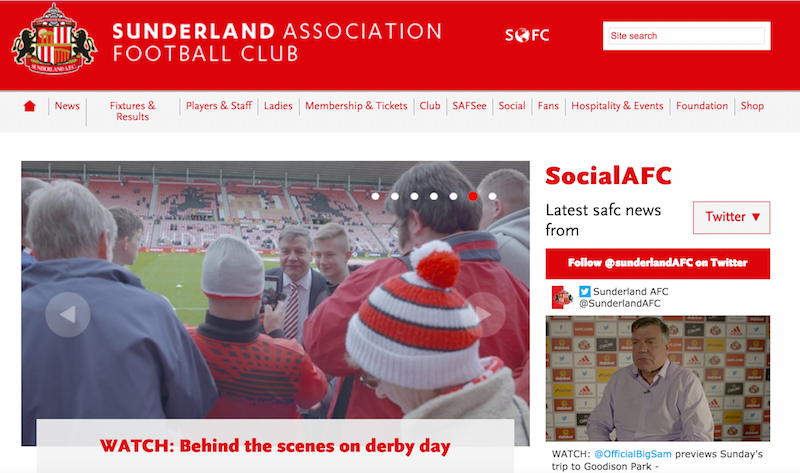
from http://www.safc.com/
Sunderland A.F.C.
- Official Website of the football club.
Added by
Simon Cotterill

from https://en.wikipedia.org/wiki….
History of Sunderland A.F.C.
- Detailed, referenced article, with photos.
Added by
Simon Cotterill

from https://commons.wikimedia.org…
Sunderland v. Aston Villa 1895 - by Thomas MM Hemy
- One of the earliest football paintings in the world, Thomas MM Hemy's "Sunderland v. Aston Villa 1895" depicts a match between the two most successful English teams of the decade.
Added by
Simon Cotterill

Co-Curate Page
Eppleton Colliery Football Ground
- Overview Map Street View Eppleton Colliery Welfare Ground. Sunderland AFC's development squad (under-23) and Ladies sides play home games at Eppleton Colliery Welfare Ground (Hetton Centre).

from Youtube (youtube)
Arsenal football team plays Sunderland at Highbury (1935)
Pinned by Simon Cotterill

from Youtube (youtube)
Chelsea and Sunderland soccer teams tie at Stamford Bridge (1937)
Pinned by Simon Cotterill


from Newcastle libraries (flickr)
044573:Newcastle v Sunderland derby match St. James Park Newcastle upon Tyne Evening Chronicle 1904
Pinned by Co-Curate Team

from Newcastle University (youtube)
Famous Football Teams In Training No. 2 - Sunderland (1934)
Pinned by Simon Cotterill

Co-Curate Page
Sunderland
- Overview About the City of Sunderland Timeline Map Street View The City of Sunderland is located in Tyne and Wear, in the North East England. The former Metropolitan Borough of …

from https://en.wikipedia.org/wiki…
Sunderland's 1937 FA Cup winning side
- Picture on Wikipedia curtesy of the Sunderland Echo. This work is licensed under the Creative Commons Attribution-Share Alike 3.0 License.
Added by
Simon Cotterill

from http://www.safc.com/
Sunderland A.F.C.
- Official Website of the football club.
Added by
Simon Cotterill

from https://en.wikipedia.org/wiki….
History of Sunderland A.F.C.
- Detailed, referenced article, with photos.
Added by
Simon Cotterill

from https://commons.wikimedia.org…
Sunderland v. Aston Villa 1895 - by Thomas MM Hemy
- One of the earliest football paintings in the world, Thomas MM Hemy's "Sunderland v. Aston Villa 1895" depicts a match between the two most successful English teams of the decade.
Added by
Simon Cotterill

Co-Curate Page
Eppleton Colliery Football Ground
- Overview Map Street View Eppleton Colliery Welfare Ground. Sunderland AFC's development squad (under-23) and Ladies sides play home games at Eppleton Colliery Welfare Ground (Hetton Centre).

from Youtube (youtube)
Arsenal football team plays Sunderland at Highbury (1935)
Pinned by Simon Cotterill

from Youtube (youtube)
Chelsea and Sunderland soccer teams tie at Stamford Bridge (1937)
Pinned by Simon Cotterill
